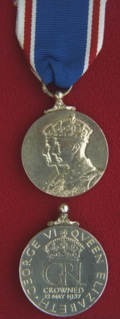Issue
This medal was awarded as a personal souvenir of King George VI's coronation. It was awarded to the Royal Family and selected officers of state, officials and servants of the Royal Household, ministers, government officials, mayors, public servants, local government officials, and members of the navy, army, air force and police in Britain, her colonies and Dominions. [1]
For Coronation and Jubilee medals, the practice up until 1977 was that United Kingdom authorities decided on a total number to be produced, then allocated a proportion to each of the Commonwealth countries and Crown dependencies and possessions. The award of the medals was then at the discretion of the local government authority, who were free to decide who would be awarded a medal and why.
A total of 90,279 medals were awarded, [1] including:
- 6,887 to Australians
- 10,089 to Canadians
- about 1,700 to New Zealanders. [2]
The medal was worn with other coronation and jubilee medals, immediately after campaign and polar medals, and before long service awards. [3] Ladies could wear the medal near their left shoulder with the ribbon tied in the form of a bow. [4]
This page is based on this
Wikipedia article Text is available under the
CC BY-SA 4.0 license; additional terms may apply.
Images, videos and audio are available under their respective licenses.
